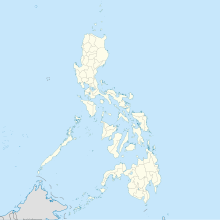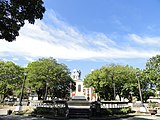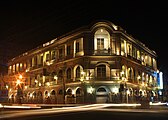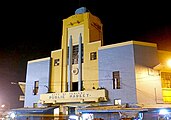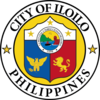Iloilo City Proper
Iloilo City Proper
La Punta (Spanish) Downtown Iloílo | |
|---|---|
Administrative and central business district | |
From top, left to right: Skyline; Eusebio Villanueva Building; San Jose Church; Old Iloilo City Hall; Museum of Philippine Economic History; Iloilo Customs House; Casa Real de Iloilo | |
| Nickname(s): Old Iloilo, Heart of Iloilo | |
| Motto(s): La Muy Leal y Noble Ciudad (The Most Loyal and Noble City) | |
 Location within Iloilo City | |
 | |
| Coordinates: 10°41′42.7194″N 122°33′52.92″E / 10.695199833°N 122.5647000°E | |
| Country | |
| Region | Western Visayas (Region VI) |
| Province | Iloilo (geographically only) |
| City | Iloilo City |
| Congressional District | Lone district of Iloilo City |
| Established | 1602 |
| Cityhood | October 5, 1889 |
| Reincorporated (as district) | July 16, 1937 |
| Barangays | 45 (see Barangays) |
| Government | |
| • Mayor | Jerry Treñas (Mayor of Iloilo City) |
| Area | |
• Total | 3.75 km2 (1.45 sq mi) |
| Population (2020 census) | |
• Total | 46,350 |
| • Density | 12,360/km2 (32,000/sq mi) |
| Demonym | Ilonggo |
| Time zone | UTC+8 (Philippine Standard Time) |
| ZIP code | 5000 |
| Area code | 33 |
| Patron saint | Santo Niño (district patronal saint) |
| Feast day | Fourth Sunday of January in honor of Señor Santo Niño or Holy Child Jesus (coincides with Dinagyang Festival) |
| Native languages | Hiligaynon |
| Website | www |
Iloilo City Proper, also known as Downtown Iloilo or simply Iloilo among locals, is an administrative district in Iloilo City, Philippines, located on the southeastern coast of the island of Panay in the Western Visayas region. It serves as the civic center of the city and province of Iloilo, hosting the seat of city and provincial governments, as well as various local, provincial, and regional government offices. According to the 2020 census, it has a population of 46,350 people.[1][2]
Before its consolidation with the surrounding municipalities, Iloilo City Proper was the old town and the original city of Iloilo. Established in 1602, it gained cityhood status on October 5, 1889 through a royal decree, and was honored with the title "La Muy Leal y Noble Ciudad" (The Most Loyal and Noble City). In 1898, it served as the last capital of the Spanish Empire in Asia and the Pacific.
In modern times, Iloilo City Proper is known for its well-preserved 19th and 20th-century architecture, particularly along J.M. Basa Street, popularly referred to as Calle Real. It remains one of the major business districts of the city, alongside the rapidly developing district of Mandurriao.
Etymology
[edit]The name "Iloilo" is derived from the older name "Ilong-ilong" (Philippine Spanish: Ilong̃-ílong̃) meaning "nose-like", referring to the promontory between two rivers (Iloilo and Batiano) where the Fort San Pedro and the 17th-century Spanish port in the district were located.[3][4][5][6] Over time, the name influenced the consolidated greater city of Iloilo, as well as the entire province.[7]
History
[edit]Spanish colonial period (1600s–1800s)
[edit]Early colonial period
[edit]Iloilo City Proper, or simply Iloilo, was founded and inhabited as La Punta in 1602 when Spanish and Chinese residents from Jaro and Molo, respectively, expanded their territorial areas. In 1700, it became the capital and the seat of power of the Spaniards in the province, which they transferred from La Villa Rica de Arevalo due to continuous attacks by Moros and Dutch.
Late colonial period and economic boom
[edit]Iloilo emerged as a trading port in the 19th century. Its geographical and economic significance eventually evolved when China, Norway, and the United Kingdom opened up their consulates to conduct trade and commerce in the town, especially during its foundation as an international port in the 1850s. As a result, the commercial activity in Iloilo increased, as well as the infrastructures, recreational facilities, education institutions, banks, foreign consulates, and commercial firms.
Cityhood
[edit]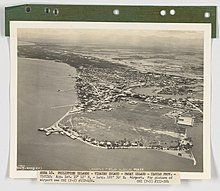
On October 5, 1889, due to the economic development in Iloilo, making it the most important port in the Philippines next to the capital, Manila,[8] Iloilo was raised from the status of a town to a city through a royal decree,[9][10] and in 1890, the city government was established.
Revolutionary period (1896–1898)
[edit]Due to the loyalty of the Ilonggos, the city of Iloilo was honored with the perpetual title of La Muy Leal y Noble Ciudad (The Most Loyal and Noble City). The royal decree granting this title was signed on March 1, 1898, by Queen Regent Maria Christina of Spain. Over time, this title earned for Iloilo the reputation of being the Queen's Favored City in the South or simply Queen's City in the South, which later evolved into the Queen City of the South, being the second Spanish port of importance next to Manila and being located south of the archipelago's capital city.
On December 25, 1898, the Spanish government surrendered to the Ilonggo revolutionaries led by Gen. Martin Delgado at Plaza Alfonso XII (now Plaza Libertad). It was site where the Philippine flag was raised for the first time on the island of Panay.[11]
American colonial period (1900–1941)
[edit]
Iloilo City consolidation
[edit]In the 20th century, all economic activities shifted from Jaro and Molo to the city of Iloilo when businesses aggressively flourished here. It was re-chartered by the American government on July 16, 1937, and absorbed the old towns of Molo, Arevalo, Mandurriao, and La Paz. On January 7, 1941, the city of Jaro was also incorporated into greater Iloilo City.
1966 Iloilo City fire
[edit]On February 7, 1966, a fire devastated Iloilo City Proper, destroying nearly three-quarters of the area. The blaze lasted approximately 12 hours and resulted in ₱50 million worth of property damage (1966 value), making it the most destructive fire in the city's history.[12][13]
21st century
[edit]Iloilo City Proper, as a district, remains the economic and political center of the city and the whole province.
Geography
[edit]Iloilo City Proper sits on the southeastern tip of Panay Island, facing the Iloilo Strait and Guimaras. It is bordered by Molo to the west, and separated from Mandurriao to the northwest, La Paz to the north, and Lapuz to the northeast by the Iloilo River. Just across the strait are Buenavista and Jordan in Guimaras.
Iloilo City Proper, along with parts of Molo and Arevalo, is surrounded by the Iloilo-Batiano river system, which formed an almost-island area that separated from the mainland of Panay in the southern part of Iloilo City.
The district is a busy commercial center and the main political hub for both Iloilo City and the Province of Iloilo. It is also where the regional government of Western Visayas operates.
Barangays
[edit]Iloilo City Proper has the most number of barangays in Iloilo City, with a total of 45.
- Arsenal Aduana
- Baybay Tanza
- Bonifacio Tanza
- Concepcion-Montes
- Danao
- Delgado-Jalandoni-Bagumbayan
- Edganzon
- Flores
- General Hughes-Montes
- Gloria
- Hipodromo
- Inday
- Jalandoni-Wilson
- Kahirupan
- Kauswagan
- Legaspi dela Rama
- Liberation
- Mabolo-Delgado
- Magsaysay
- Malipayon-Delgado
- Maria Clara
- Monica Blumentritt
- Muelle Loney-Montes
- Nonoy
- Ortiz
- Osmeña
- President Roxas
- Rima-Rizal
- Rizal Estanzuela
- Rizal Ibarra
- Rizal Palapala I
- Rizal Palapala II
- Roxas Village
- Sampaguita
- San Agustin
- San Felix
- San Jose
- Santo Rosario-Duran
- Tanza-Esperanza
- Timawa Tanza I
- Timawa Tanza II
- Veterans Village
- Villa Anita
- Yulo-Arroyo
- Zamora-Melliza
Economy
[edit]
Iloilo City Proper is the hub for trade, commerce, banking, finance, education, retail trading, real estate, and industry in Iloilo since its establishment in the early 17th century. As the original territory of the city of Iloilo, it has maintained its position as an economic center of the city. The district is known as the financial capital of Western Visayas, boasts one of the highest concentrations of banks and financial institutions in the country.[14] Calle Real, along with Iznart St., Gen. Luna St., and Ledesma St., is home to many service and commercial establishments.

Iloilo City Proper is also houses significant government buildings, including the Iloilo Provincial Capitol, which serves as the main government building of the Province of Iloilo, and the Iloilo City Hall, which is the seat of the city government. Various other government agencies are also located within the City Proper.
Since its foundation as an economic hub, the district has faced space limitations for further growth. In recent times, several proposals have arisen for island-type reclamation along the southern shores of the City Proper. The expansion plan aims to expand the district's commercial area, considering that modern developments have concentrated in the other districts, specifically Mandurriao, over the past two decades.
Education
[edit]Iloilo City Proper is home to half of the universities in Iloilo City. Some of the notable universities and schools in the district are the following:

Higher education institutions:
- University of the Philippines Visayas – founded in 1947.
- University of San Agustin – the first university in Western Visayas, founded in 1904.
- University of Iloilo – founded in 1947.
- St. Paul University Iloilo – founded in 1946.
- Hua Siong College of Iloilo – founded in 1912.
- Colegio de las Hijas de Jesus – founded in 1936.
- Colegio del Sagrado Corazon de Jesus – founded in 1917.
- Cabalum Western College – founded in 1945.
Basic educational institutions:
- Assumption Iloilo
- Sun Yat Sen High School
- Ateneo de Iloilo – Santa Maria Catholic School
- Iloilo Central Elementary School
- SPED Integrated School for Exceptional Children
- Iloilo American Memorial School
- Manuel L. Quezon Elementary School – Kahirupan
- Rizal Elementary School – Bonifacio Tanza
- I. Arroyo Elementary School
- San Jose Elementary School – Rizal Street
- Rizal Elementary School
- Center for West Visayan Studies
- A. Montes Elementary School I
- A.Montes Elementary School 2
- Fort San Pedro National High School
Transportation
[edit]
Public transport
[edit]The primary modes of public transportation in Iloilo City Proper are passenger jeepneys and metered taxis. The transportation routes in Iloilo City are mostly focused on the district, which is the center of commerce in the city.

In contrast to President Rodrigo Duterte's administration's plan to phase out old, dilapidated jeepneys as the primary mode of mass public transportation in the Philippines, the city has recently begun to adopt mini-buses like modern PUJs or modern Jeepneys that are now plying in the city, including Iloilo City Proper.[15][16]
Cycling
[edit]Iloilo City has been hailed as the Bike Capital of the Philippines. There are also several painted bicycle lanes in Iloilo City Proper that can be found on its main roads, including General Luna Street, Delgado Street, Mabini Street, Infante Street, and the esplanade along Muelle Loney Street.[17]
Railway
[edit]From 1907 to the 1980s, Panay Railways operated a railroad from Roxas City to the port area of Iloilo City Proper.[18] In 2022, Panay Railways announced its opening to foreign ownership to reconstruct its former train lines, which will reconnect the district and city to other major cities in Panay, including Caticlan in Malay, Aklan.[19]
Airport and seaport
[edit]
The Iloilo International Airport in Cabatuan, Iloilo, is the primary airport serving the district of Iloilo City Proper, as well as the whole Metro Iloilo–Guimaras. It serves domestic air routes to Manila, Clark, Cebu, Cuyo Island, Puerto Princesa, Sipalay, Cagayan de Oro, General Santos, and Davao City. It is also served by international routes to and from Singapore and Hong Kong.[20]
The Port of Iloilo, which is located near Fort San Pedro, Iloilo City Proper, serves domestic shipping and cargo routes to/from Manila, Cebu, Puerto Princesa, Bacolod, Cagayan de Oro, Zamboanga City, Davao, and General Santos. The Iloilo International Cargo Port, in the adjacent Lapuz district, is a port of call for foreign cargo vessels.
The Guimaras-Iloilo Ferry Terminal, which is located in Parola, serves ferry routes to Jordan and Buenavista in Guimaras, and vice versa.
Gallery
[edit]-
San José de Placer Church, the first ever church in the city of Iloilo, and was built in 1607.
-
Plaza Libertad, a historic plaza where the flag of the first Philippine Republic was raised.
-
Calle Real, a historical street, contains several fine neoclassical, beaux-arts, and art-deco buildings.
-
Eusebio Villanueva Building, once known as the International Hotel, located along Calle Real.
-
Iloilo Central Market, an art-deco public market, built during the early 20th century.
-
Museo Iloilo, a museum that houses the city and province of Iloilo's cultural heritage.
-
Lin-ay sang Iloilo (Lady of Iloilo), an 18-foot bronze statue on top of Iloilo City Hall's dome.
-
Aduana de Iloilo (Iloilo Customs House), one of the three customs houses in the Philippines.
-
Edificio de Elizalde y Cia, a hundred-year-old structure that now houses the Museum of Philippine Economic History.
See also
[edit]References
[edit]- ^ "Iloilo...My City...My Pride". Archived from the original on January 21, 2012. Retrieved February 20, 2012.
- ^ 2021–2029 Iloilo City Comprehensive Land Use Plan (CLUP) Volume 1
- ^ de Mentrida, Alonso (1841). Diccionario De La Lengua Bisaya, Hiligueina Y Haraya de la isla de Panay. En La Imprenta De D. Manuel Y De D. Felis Dayot. pp. 202–203.
- ^ Doeppers, Daniel F. (2017). "The Development of Philippine Cities Before 1900". In Frost, Lionel (ed.). Urbanization and the Pacific World, 1500–1900. Lands, Peoples, and History of the Pacific, 1500–1900. Vol. 15. Routledge. ISBN 9781351876346.
- ^ Law, Gwillim (2015). Administrative Subdivisions of Countries: A Comprehensive World Reference, 1900 through 1998. McFarland. p. 289. ISBN 9781476604473.
- ^ Romuáldez, Norberto (1908). A Bisayan Grammar and Notes on Bisayan Rhetoric and Poetics and Filipino Dialectology. Tacloban: Pag Pahayag Co.
- ^ "Iloilo...My City...My Pride". Archived from the original on January 21, 2012. Retrieved February 20, 2012.
- ^ Funtecha, Henry (2000). "The Urbanization of the Town of Iloilo, 1865–1900". Selected Papers on Cities in Philippine History. Philippine National Historical Society: 89–108.
- ^ The actual words of the Royal Decree says: "A propuesta del Ministro de Ultramar, y teniendo en cuenta el creciente desarrollo que en la industria y el commercio ha alcanzado la cabecera de la provincia de Ilo-Ilo, la más importante de las islas de Filipinas, despues de la de Manila; En nombre de mi Augusto Hijo el Rey D. Alfonso XIII, y como Reina Regente del Reino, Vengo en conceder el titulo de la Ciudad á la cebecera de Ilo-Ilo, en dichas islas. Dado en San Sebastian á cinco de Octubre de mil ochocientos ochenta y nueve. Maria Cristina" Cf. Decreto Real de la Reina Regente Maria Cristina (5 Octubre 1889) en Gazeta de Madrid, N. 298, 25 Octubre 1889, p. 238.
- ^ "TIF file".
- ^ John, Foreman, The Philippine Islands: a political, geographical, ethnographical, social and commercial history of the Philippine Archipelago, embracing the whole period of Spanish rule, with an account of the succeeding American insular government, New York: 1907, C. Scribner's Sons, p. 478.
- ^ Albay, Rhick Lars Vladimer (October 13, 2018). "Unwavering Federation Fire". Panay News. Retrieved October 23, 2024.
- ^ Tayona, Glenda (January 30, 2023). "MORNING INFERNO: Fire razes nearly 300 Molo houses; Over 1,000 residents displaced". Panay News. Retrieved October 23, 2024.
- ^ Nicolas, Jino (January 23, 2018). "The beacon of Western Visayas". BusinessWorld Online. Retrieved July 4, 2022.
- ^ Modern jeepneys to ply 3 new Iloilo routes. Retrieved October 26, 2018.
- ^ 'Modernized' jeeps start plying Iloilo routes. Retrieved October 26, 2018.
- ^ Tour on two wheels: Seeing Iloilo City's historic sights by bike. Retrieved October 26, 2018.
- ^ "Panay Railways". www.thenewstoday.info. Retrieved July 19, 2022.
- ^ Guardian, Daily (March 23, 2022). "Panay Railways chief open to foreign ownership to rehab defunct rail system". Daily Guardian. Retrieved July 19, 2022.
- ^ "Philippines' Iloilo airport readies for int'l flights". Archived from the original on November 10, 2012. Retrieved October 29, 2016.









